Rooting Android is trendy nowadays. As we know, Android is an open-source operating system. Because of this, we can do a lot of things on Android smartphones and tablets. Unlike other smartphones OS, Android allows users to browse system files on their Android devices. But, for that, you have to root your device. Rooting Android means getting superuser permission on the device. So, you can modify the system files of your device when you root it. However, many times, users need to unroot their devices. But, they aren’t able to do that. So, in this post, we’ll share the methods of how to unroot Android easily.
As we know, rooting your Android device isn’t an easy task. You need different methods to root different Android smartphones or tablets. However, that’s not the case when you want to unroot your device. Because the unrooting process is pretty simple and easy. Below, we have shared some methods to do that. You can follow the methods and know how to unroot your Android device easily without any issues. So, read this post completely if you want to unroot your Android smartphone and tablets.
Table of Contents
What is Rooting?
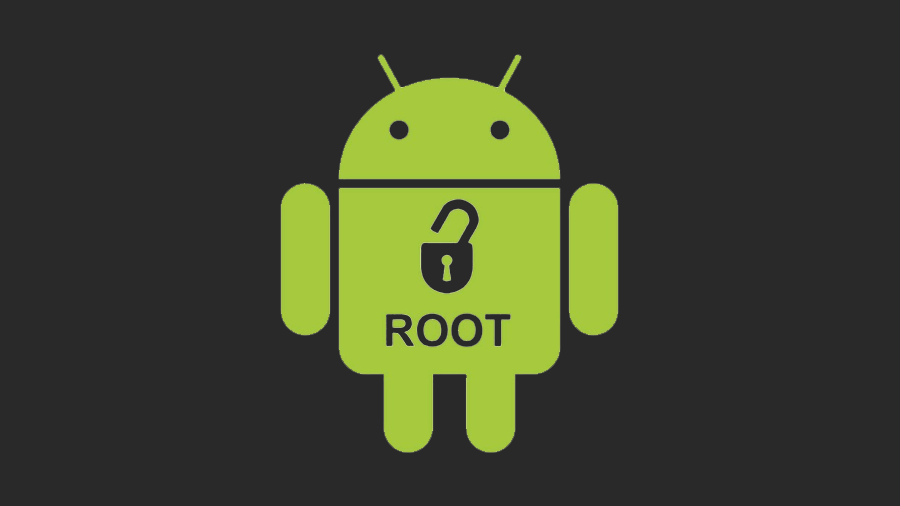
Rooting is a process that users follow on Android. Rooting means getting superuser access on your device. When you root your Android device, you can modify the system files of your device and can do a lot of things. There are many Android apps that require root permission on Android. So, if you want to use those apps, you need to root your device. Without rooting, you can’t use the apps on your device. So, if you want to use some particular apps, you have to root your Android device and use those apps. Many users also root their device to Free up the Internal Storage of their device.
Also, root permission gives full access to your Android device. So, you can modify any file you want on your device. Most of the people want to customize system files on their devices. So, for them, rooting is mandatory. Also, there are many people who love to modify Android apps and games. They want to modify the source code of the games using particular apps and then get in-app purchases for free on their devices. And most of the time, the apps that help the users to do that require superuser permission on the devices. So, if you have already rooted your device, you know what the benefits of rooting are. But, let’s talk about unrooting Android devices. Why do you need to unroot your device?
Why Unroot Android Devices?
Security Reasons
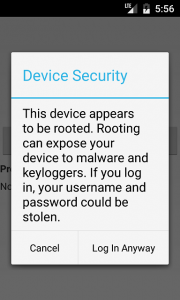
The most obvious reason for unrooting is because of the security of the device. When you root your device, it compromises the security of your Android device. How? Let me tell you how rooting your Android smartphone or tablet will compromise the security of your Android device. By default, Android OS doesn’t allow users to get access to system files. So, even if you get a virus, malware, or Adware on your device, the virus can’t modify the system files of your device.
However, when you root your Android device to access the system files, it unlocks all the system files access. That means any app installed on your Android device can get access to your system files. So, if you get a virus or malware on your device, it’ll be able to access your system files, hence comprising the security of your device. This is the reason rooting Android is not recommended unless you know what you are doing. It can seriously hard the security of your device and compromise the privacy of your Android device. So, you should unroot your Android device if you want to restore the security.
Use Financing Apps

If you have a rooted Android device, you probably have noticed that you can’t use particular Android apps on your device. Especially for finance apps like Google Pay, it won’t work on a rooted Android device. The reason many apps don’t work on rooted Android devices is simple. They care about the security of your Android device. These apps protect your security by not giving access to rooted Android devices. As financing apps are sensitive, they don’t allow rooted device users to use their apps.
So, if you are not able to use finance or banking apps like Google Pay, you can unroot your Android device and get access. After unrooting, you’ll be able to unlock and open those apps on your Android device. It is a good thing that finance apps don’t work on rooted Android smartphones. But, those who have a rooted device often face problems while using these apps on their devices. For them, unrooting is the only solution. However, if you have rooted your device using Magisk, then you get a Hide Magisk option to hide rooting for such apps. But, this feature won’t work properly. So, the last thing that you can do is, you can unroot your device to use these financing apps.
Void Phone Warranty

When you root your Android device, you’ll see a clear message on the app that you are using to root your device. It says that after rooting, the warranty of your device will be void. It’s a clear message, and most of the people know that. However, the good thing is, even after rooting, if you unroot your Android device, you can reclaim the warranty of your device.
Yes, the warranty will remain the same when you unroot your device. So, for the users who want to reclaim the warranty of their devices, unrooting is the best option. If you have already rooted your Android device and want to reclaim the warranty of your device, you can simply get it by unrooting your device. It is a very easy process and gives you a lot of benefits.
Below, we have shared some of the best methods to unroot your Android device. So, if you want to unroot your device, just follow one of the below methods, and you’ll be able to successfully unroot your device.
How to Unroot Your Android Device?
1. Universal Unroot
![]()
This is a simple and easy method to unroot your device. However, it is not a stable method. You can unroot your Android device in a single click with the help of the universal unroot app. Universal unroot is a free Android app that helps users to unroot their devices. It provides a one-click unroot feature, which is a great thing. Users who don’t want to spend time to unroot their device can use the universal unroot app to unroot their devices. And it is completely free to use the app.
However, this method doesn’t work on many Android devices. So, you can try unrooting your device using the universal unroot app and see if you are able to unroot it or not. Below, we have described the process of unrooting your device using the universal unroot app.
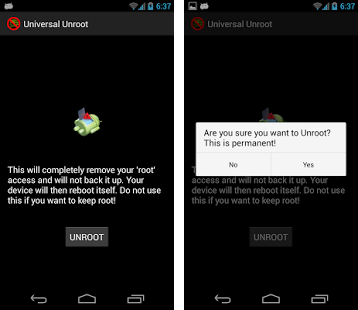
- First of all, download the Universal Unroot app on your rooted Android device and install it.
- Open the app on your device.
- You’ll see an ‘Unroot’ button on the app. Click on it to unroot your device.
- Confirm unrooting and process.
- That’s it. Now, your device will be unrooted, and you can check it using the Root Checker app.
2. Using SuperSu
![]()
If you have installed SuperSU on your Android device, and want to unroot your device, then you can also do that easily. SuperSu is an Android app that helps other apps to get Superuser permission. However, it also has an unroot option. So, just like the previous app, you can also unroot your Android device using the SuperSu app. And the best part is, it also provides a one-click unroot feature on your device.
And unlike the previous method, unrooting your Android device with SuperSu is a stable method. And it works on most of the Android devices. So, you’ll be able to successfully unroot your Android device using the SuperSu app easily. Follow the below instructions to unroot your Android device using the SuperSu app easily. To unroot the device, you have to get the SuperSu Pro.
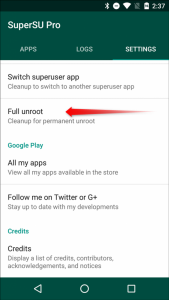
- Download the latest version of SuperSu Pro on your device and install it.
- Open SuperSu on your device.
- Now, go to the ‘Settings’ option of SuperSu, and you’ll find the ‘Full unroot’ option. Click on it.
- Now, it’ll ask to continue unrooting your device click on ‘Continue.’
- That’s it. Now, you have successfully unrooted your Android device. Use the Root Checker app to check it.
3. Use Magisk to Unroot Android
![]()
Most of the modern devices support Magisk root. And most of the users nowadays use Magisk to root their devices. So, if you have rooted your Android device with Magisk, then you can also unroot it using the app. Unrooting your device with Magisk is a simple and easy option. Just like the previous methods, Magisk also provides a one-click unroot feature on your device. So, you can unroot your device completely using Magisk.
And if you have successfully rooted your device with Magisk, then you can also unroot it completely using Magisk. Magisk is a stable method to unroot your Android device completely. Below, we have provided the step by step method to unroot your device using Magisk. So, you can follow the steps to unroot your Android device completely using the Magisk app.
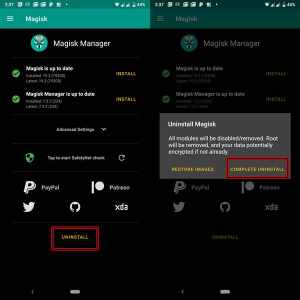
- Open Magisk on your device.
- On the homepage, you’ll find the ‘Uninstall’ button of Magisk. So, you can click on that to unroot your device.
- Confirm uninstalling Magisk and uninstall magisk completely from your device.
- That’s it. Now, you have successfully unrooted your Android device using Magisk. Now, check the root status using the Root Checker app.
4. Using the Root App
![]()
There are many apps that are available that helps the users to root their Android devices. Some of them are Kingroot, Kingoroot, iRoot, Towelroot, etc. You can use any of these apps to root your Android device. Each of these apps has a different success rate of rooting your device. So, many users prefer to use different apps to root their devices. If you have used any of these apps to root your Android device, then you can also reverse the process and unroot your Android device using the app.
Usually, most of these root apps have an option to unroot the device. You can use the option and unroot your Android device successfully. And it’s a stable method. If the app is able to root your Android device, then it’ll also be able to unroot your device. So, you can unroot your device completely from the rooting app itself.
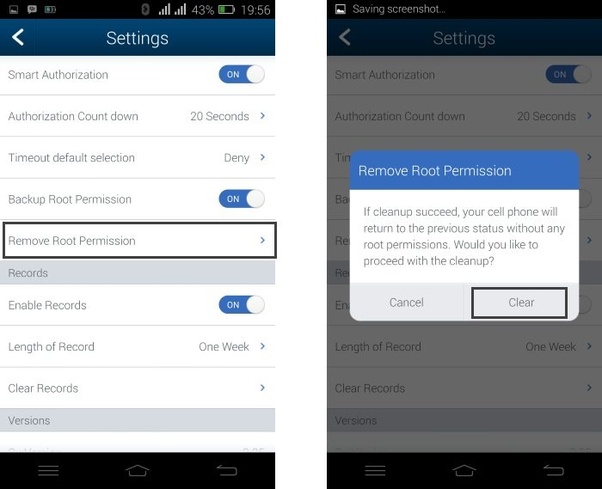
- Open the app that you used to root your device.
- Now, go to the Settings of the app, and you’ll find the option to unroot the device. The unroot option might be different on different rooting apps. So, you have to find it yourself. You’ll find options like ‘Uninstall,’ ‘Remove Root permission,’ ‘Remove root,’ etc. So, just click on the option.
- That’s it. Now, you can check the root status of your device using a root checker app.
5. Flash Firmware to Unroot Android

This is the ultimate method to unroot your Android device. You can flash the stock firmware of your device and remove the root from your device. However, it is the most complicated method. So, if you are a beginner, and you haven’t flashed an Android device once, then it’s not recommended to flash your Android device because it can brick your Android device.
However, if you successfully flash your Android device, then the root access will be removed completely. So, unless the above methods are not working, you shouldn’t flash your Android smartphone. If you want, you can try flashing your device but carefully. You can find plenty of guides on the Internet to flash stock firmware on Android. If you are using a device like Samsung Galaxy Note 8, you can Install Oreo 8.0 Firmware on your device and unroot it.
Final Words
So, guys, I hope you have found this post helpful. If you liked, you can share this post on your social media platforms. Just use the share buttons below to share this post. If you have any questions or queries, you can ask them in the comment section below. You can also provide your feedback in the comment section.











![How to Unlock Bootloader without PC On Android [2022]](https://cracktech.net/wp-content/uploads/2019/02/unlock-boot.png)